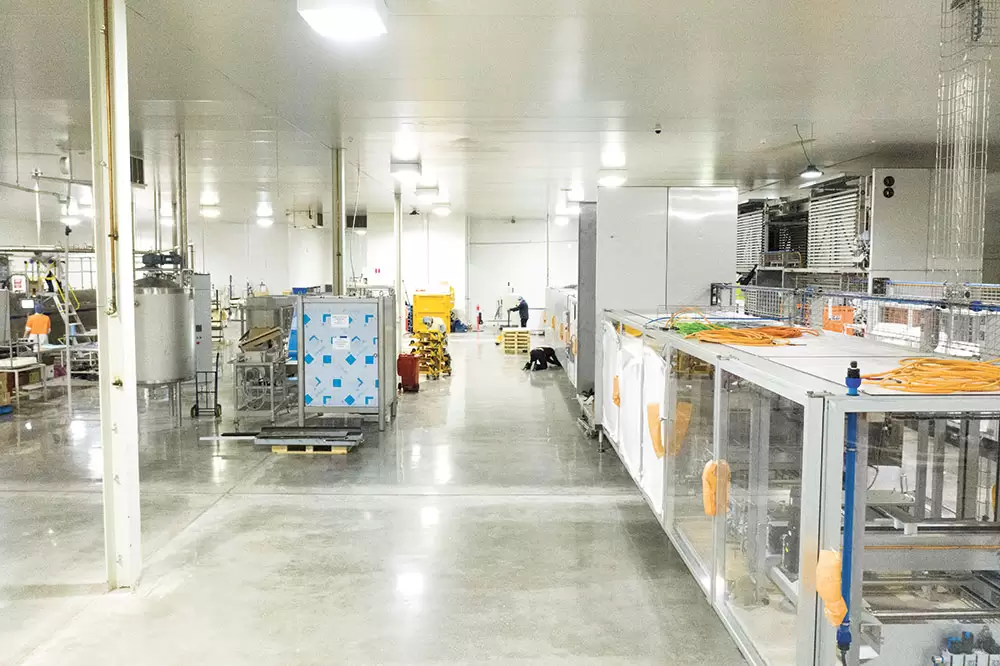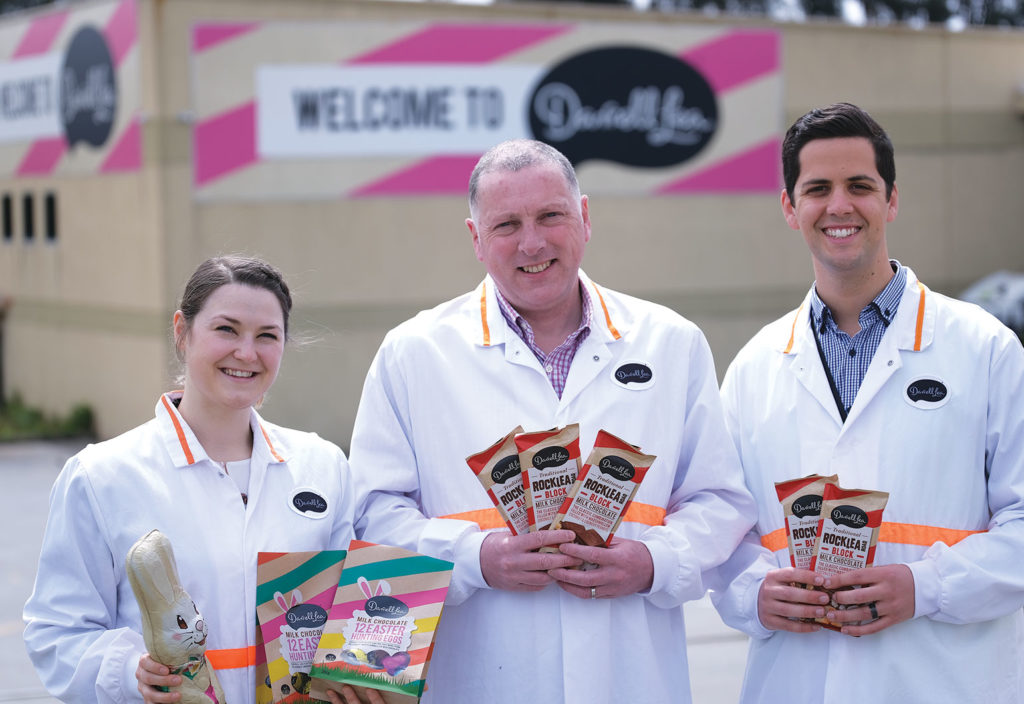Chocolate-making is a complex process requiring advanced machinery, considerable engineering skill and a bit of magic.
Darrell Lea is known by 80 per cent of Australians for its confections. Research conducted in 2018 confirmed that it was best known for its chocolate, but at that point it was almost wholly a liquorice business. So, the business developed plans for an entry into the biggest category of chocolate blocks, along with a Trojan horse of seasonal products, getting Darrell Lea into every household.
In 2018, a factory was purchased that had both capabilities. Darrell Lea now needed to deliver the vision of unique chocolate blocks and hollow moulded products.
The Australian confectionery icon Darrell Lea has been adored by generations of sweet-tooths. Prior to 2019, however, it had never produced a chocolate block.
You’d think it would be a simple task for a company with almost 100 years of chocolate-making experience to its name, but creating the humble block presented significant challenges that only a highly skilled engineering/technical team could overcome.
Darrell Lea was founded in Sydney in 1927 by Harry Lea and is famous for Rocklea Road — a decadent mashup of fluffy marshmallow, coconut, peanuts and milk chocolate, which Harry invented in 1955 as a gift for his wife, Esther.
Until recently, however, soft liquorice made up about 80 per cent of Darrell Lea’s manufacturing output. Each year, it produces the equivalent of 40,000 km of the sticky confection — enough to wrap once around the world
But the past decade has brought significant changes to Darrell Lea. After entering liquidation in 2012, ownership of the company moved from the Lea family to the Quinn family and its more than 800 products were reduced to a range of about 100.
In 2018, the company was sold to Quadrant Private Equity, and with new ownership came a new vision — to take for a bigger slice of Australia’s $3 billion chocolate market.
Sweet innovations
Justin Carline FIEAust CPEng NER has been instrumental in bringing this vision to life. Justin began his career at British Aerospace (now Airbus), later moving into the fast-moving consumer goods industry and has spent more than a decade overseeing global innovations at snack-food giant Mondelēz International, owner of brands such as Cadbury, Pascall and Oreo, before joining Darrell Lea in December 2018.
With a strategic plan in place, Darrell Lea acquired a ready-built chocolate factory in 2018 as the manufacturing site for the new range of chocolate blocks. With the vision to build a Chocolate Centre of Excellence, the team set about the task of developing a new range of chocolate block innovations. The key to success was in being able to use larger and more generous inclusions than the competition.

Chocolate-making is a complex process — and a sweet engineering innovation. The mechanics behind a chocolate block are just the beginning. Viscosity, for instance, can make or break the process. Fluidity in a melted state is directly relating to how it will perform, so engineering the right chocolate properties for a specific application is vital to success.
After a few significant challenges presented themselves, Justin received a phone call to provide technical input.
Arriving at the factory, the use of large and generous inclusions required a different approach to the classical engineering design used elsewhere.
What was a two-week stint to help iron out a few technical issues within Darrell Lea’s chocolate-block manufacturing became a mission of pride to develop the best chocolate bar within the Australian market. With a successful launch, Justin’s role expanded significantly, with Justin now leading the company’s Centre of Excellence in Melbourne’s South-East, overseeing new confectionery innovations, and transforming the site to be world class.

Justin brought a depth of technical know-how to Darrell Lea’s chocolate block challenge — and a great deal of energy and tenacity.
“The moulding machine being some five years old and with only a few hours on the clock, never truly tested” Justin said.
“We had well over 250 issues to solve, and what didn’t help was the original manufacturer of the machine had gone broke, so we couldn’t call on them for support. We had to use all of our inbuilt primary senses to observe what was happening to the ingredients as they flowed through the machine, and then as a united team, reverse engineer, fixing the defects.”
Challenge in the chocolate factory
A chocolate moulding machine is essentially a large stainless-steel refrigerated box, about two metres wide and 10 metres long. At one end, a depositing head deposits chocolate into a mould. The moulds are then vibrated to even out the chocolate, before travelling through a cooling tunnel for about 40 minutes. The blocks are then demoulded and wrapped.
But there are additional layers of complexity. Chocolate is deposited as a liquid mass in volumetric form and sold by weight in solid form. Inclusions like marshmallow are lighter, with a lower density than chocolate. So how do you stop them from floating to the top of the block?
A piece of Darrell Lea marshmallow is equivalent to seven grams of chocolate — add too many or too little and you will impact the declared weight of the chocolate block.
“When you get massive variations in your bar weight, it affects the height of the block, which then affects the packing line,” Justin said.
“There are 15 blocks per box, so get this wrong, only 14 blocks will fit, and then you’ll have to start again.”
Perfecting the flow
Process engineer Jordan Kannar joined Darrell Lea at the beginning of 2019 and says Justin taught him a lot about the properties of chocolate – their signature chocolate block being Rocklea Road.
“Getting marshmallow and chocolate to mix well so that you have an evenly distributed block was a difficult task,” he said.
“We would often have a lot of marshmallow coming through, or none at all. I think Justin’s technical prowess really came into play in getting the chocolate viscosity correct, so that the moulding line could perform. In trying to solve the problem, I flew to Europe to meet technical suppliers, consultants and chocolate experts to find a solution. On returning to Melbourne we set about implementing the new learnings.
“Once we had viscosity sorted out, we were able to fix problems with depositing, then we got the marshmallows to work and then everything else fell into place.”
With its technique perfected, Darrell Lea’s chocolate blocks hit the shelves in May last year and the range has since grown to 15 flavours. The company is now gearing up for new innovations within chocolate.
In October this year, the troublesome chocolate moulding plant was replaced with a new state of the art, multi-million-dollar investment. The new moulding plant was designed and manufactured in Italy, with parts sourced from across Europe.
“It’s the best money can buy, and it is with pride that we designed and engineered everything in house” Justin said.
“The new machine is cutting edge and will allow Darrell Lea to continue to delight consumers with bigger and better innovations. It’s fully Industry 4.0 compliant, very high tech and an engineer’s dream to work with.”
Jordan’s earlier visit to Europe, was a great opportunity to pull together an international team of technical experts to support the design, build and recently commissioned moulding plant.
Darrell Lea currently employs seven technically skilled engineers at its Rowville factory with Justin believing the number may soon expand.
“What we’ve done within the business is truly transformational and there is recognition of the local skill and capability we’ve been able to provide,” he said.
“We have had support from local government, local universities, local industry and interest from local schools.
“There is a second factory on our [Rowville] site that is ready for expansion, there is definitely a long-term plan in place. As the Centre of Excellence for chocolate, we may soon start making our own inclusions here onsite, as well.
“This will require a bigger team, more assets and more technical skills,” adds Justin. “It’s all about delivering top quality consumer innovations so that we can gain an even greater edge in the market.”
Making chocolate bunnies
Christmas is almost here, but engineer Åsa Milner is already thinking about Easter 2021.
Åsa has been working on the production of Darrell Lea’s range of chocolate Easter bunnies and eggs since joining the company this past February as Optimisation Engineer for Seasonal and Easter production.
She describes it as a “tricky” engineering feat.
“Darrell Lea is unique in that it has so many inclusions, like marshmallow and liquorice, and our bunnies and eggs are designed to represent the flavours of the chocolate blocks,” she said.
“But the way the inclusions behave when moulding an egg or a bunny is very different to how they behave when moulding a block of chocolate.”
So for this task, Åsa needed a whole new set of learnings.
While block moulds are shaken to even out the chocolate, hollow eggs and bunnies are spun on their axes.
“The inclusions change the properties of the chocolate a little bit, and it doesn’t spread in the way that a block would,” Åsa said.
“I play with inclusion and chocolate ratios to get it just right.”
Darrell Lea’s Rowville factory manufactures 22 Easter products and Åsa works closely with product developers at the company’s Ingleburn factory in Sydney’s south-west.
“They tell me the flavours that they want, and I create a process to make the magic happen,” she said.
